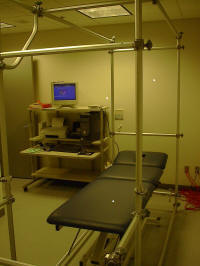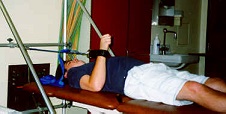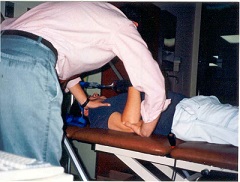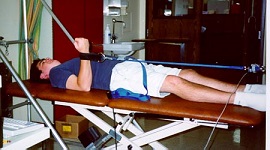

FIXED MYOMETRY
FIXED MYOMETRY muscle assessment
utilizes a relative fixed point that a patient/subject is instructed
to exert maximum effort.
An in-line force transducer (load
cell) is secured to the fixed point (frame), and a strap or cable is
extended to a cuff. The cuff is worn by the patient /subject,
and the patient is positioned on an examination table in such a way
as to isolate a muscle or muscle group to evaluate. The
test is started, the patient is directed to exert effort, and the
resultant data is displayed as a trace (force/time graph curve).
The analog signal received from the force transducer is digitized by
the acquisition converter in the pc/laptop and converted to data
within a usable file format. Over time additional data may be
acquired for longitudinal comparative analysis.
All acquired data may be exported to MS
Excel for analysis, utilizing a sub-routine in QMA.
Fixed Myometry permits evaluating stronger extremities that
may exceed 200 lbf be assessed without compromise. Mechanical
compromises of testing may occur when the effort exceeds either the
maximum capacity of the instrument, or the effort permits the fixed
point (plane of resistance) to be moved. Mechanical compromise
of testing may occur when the effort is small, and the upper
capacity of the instrument large. The maximum margin of error
(accuracy) of the instrument may exceed the effort measured.
It is recommended to utilize instruments (force transducer) that
complement (slightly exceed) the anticipated efforts of the patient.
Instruments are normally available in a range from 1.1 lbf to 1000
lbf.
Hand grip and pinch strength and fatigue, and the acquisition of the
release or back slope of a Hand grip MVIC with relaxation test (exp. Myotonic Dystrophy) may be
mined, analyzed and assessment documented, .
Oral performance (IOPI)(tongue, lip, jaw
assessment) is also available for research.
Critical criteria for test validity is that the acquisition of the
data be accurate and repeatable. Accuracy of an input
instrument may be easily confirmed or improved with "Check & Tweak"
- a sub-routine within QMA. Repeatability or inter-rater
reliability may be improved when each member of a study group is
trained and utilize the same techniques and methodology when testing
a patient.
The following are photos of QMA basic setup, assessing equipment and various
Tests in process.

QMA Testing Area Setup /
Double Click on Photo to Enlarge



Testing Elbox Extension
Testing Elbox Extension Stablized Testing Elbow Flexion

Testing Knee Flexion Stabilized
Testing Ankle Dorsiflexion Stabilized
The QMA System utilizes a remote switch that permits the testing
healthcare professional to remain in contact with the patient,
to stabilize the patient during testing and to move from test to test as each test is concluded satisfactorily.
Instruments are available to assess hand grip, pinch (key, tip and
palmar, and specialty tests; such as tongue strength for Speech
Pathology or the diagnosis of Bulbar amyotrophic lateral sclerosis (ALS).
Other Input Instruments include:
1.
Hand Dynamometer with
analog output - Grip Strength.
2.
Pinch Dynamometer
with analog output - Pinch / Tip, Key, and Palmar.
3.
IOPI Tongue Strength
Appliance - integrated into QMA